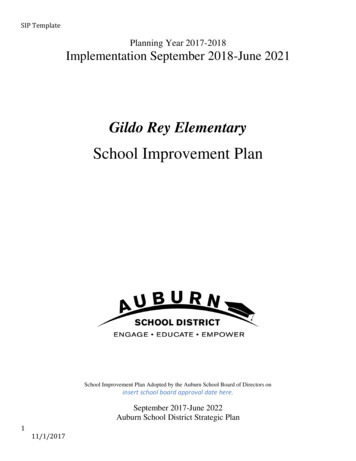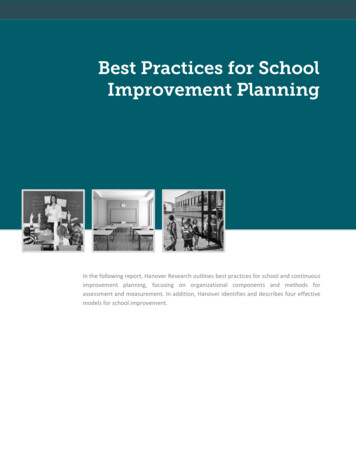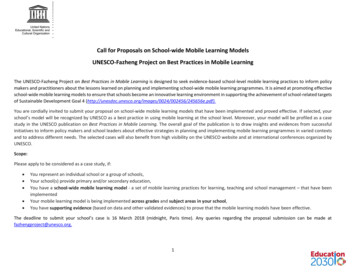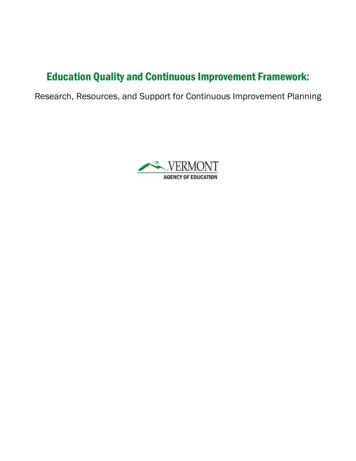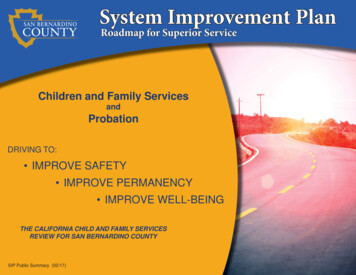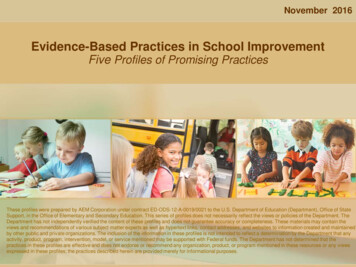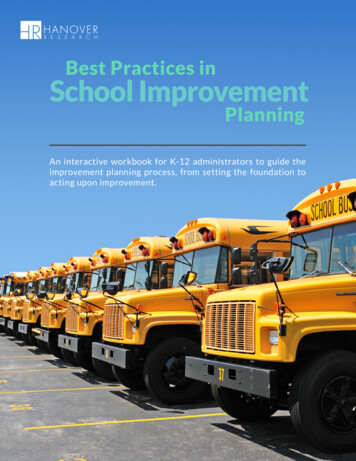
Transcription
Best Practices inSchool ImprovementPlanningAn interactive workbook for K-12 administrators to guide theimprovement planning process, from setting the foundation toacting upon improvement.1Hanover Research I K-12 Education I Best Practices in School Improvement Planning
Best Practices inSchool ImprovementPlanningSchool improvement planning is a systematic, data-driven process for planning and evaluatingimprovement over time. Distinct from institutional research and auditing, improvement planning aims toreduce the gap between a school’s current level of performance and its potential performance.At its most effective, school improvement planning is a dynamic practice that engages data and peoplein the improvement process. However, many plans fail to address the processes for improvement, insteadfocusing solely on the outcomes of improvement.To help schools and districts use school improvement planning most effectively, Hanover Researchreviewed the literature and spoke with education experts to determine not only what administratorsshould consider when developing their improvement planning framework, but also how to achieve eachspecific improvement goal.Table ofContentsI.Steps for School Improvement Planning 3A three-phase planning framework that provides best practices tips, from plan creation toimplementationII.Data Collection Needs and Variables 6A worksheet outlining six key components for capturing and acting upon improvement dataIII.Implementation Considerations 12A checklist to guide progression from one planning step to the next2Hanover Research I K-12 Education I Best Practices in School Improvement Planning
I. Steps forSchool Improvement PlanningSTEP 1STEP 2STEP 3Set theFoundationDevelop anImprovement CultureAct UponImprovement1. SET THE FOUNDATIONUNCOVER AREAS FOR IMPROVEMENTConducting a needs assessment will identify current gaps and their driving factors. Emphasize student learning and performance over specific teachers’ practices and actions. Compare different schools within the system to identify trends in school climate and culture,curriculum and instruction, leadership, family and community engagement, professionaldevelopment and staff capacity, and assessment techniques. Use third parties to evaluate school data, instruction, internal processes and procedures, andexternal policies or community factors that may impact success.SET RIGOROUS YET ATTAINABLE GOALSFocusing efforts on a few key goals supports positive morale and continued improvement. Target two to five priority areas. Reading achievement, math achievement, and school climateare common areas of improvement plan focus. It is helpful to select priority areas based onexisting school and district initiatives to prevent stakeholders from being overwhelmed bynew concepts. Align your long-term goals with the academic calendar, but divide short-term targets byquarter, month, and even week.3Hanover Research I K-12 Education I Best Practices in School Improvement Planning
Steps for School Improvement Planning2. DEVELOP AN IMPROVEMENT CULTUREESTABLISH SUPPORT STRUCTURESEngaging staff as partners in improvement ensures buy-in and engagement with the process. Create leadership groups comprising of the principal, assistant principal(s), and teacher advocates. Build district implementation taskforces of 8-12 individuals that are responsible for communicatingwith schools, and delivering ongoing support through site visits and training sessions. Provide access to professional development opportunities before launching your plan to ensureprincipals are prepared to exert transformational, instructional, and strategic leadership.USE DATA TO DRIVE DECISION-MAKINGImplementing, measuring, and assessing school improvement across a variety of metrics provides criticalinformation for improvement plans. Understand student learning trends by analyzing assessment data, curriculum delivery, social andemotional learning, and attendance and drop-out rates. Identify strengths and challenges in your school climate by surveying parents, teachers, andstudents, as well as the community. Develop benchmarks to monitor plan implementation by setting and measuringpre-determined success metrics.STRATEGY IN ACTIONAlexandria City Public Schools (ACPS) developed a stakeholder taskforce when embarking onits middle school improvement initiative. Hanover Research distributed best practicesresearch to help all taskforce members gain a common, research-driven understanding of priority areasthroughout the school improvement planning process.“The Middle Schools for Tomorrow Workgroup was brought together to allow parents, students, teachers, and thelarger community to take an active role in crafting their vision of the future for ACPS middle schools. The workgroupwas asked to create their idealized middle school, take a critical look at current practices within Alexandria middleschools, and ultimately lay the groundwork for how the division should move strategically forward.Hanover Research, in conjunction with school division staff, were integral in this work by supplying best practicesresearch around identified topics, crafting and administering a survey, providing quantitative and qualitative dataanalysis, and responding to stakeholder feedback throughout the six-month process. Decisions are only as good as theinformation used in forming them, and the research and data analysis provided allowed the stakeholder group tomake the highest quality decisions not only in reaction to where our middle schools had been, but also moreimportantly where they must go.”Clinton Page, Chief Accountability Officer, ACPS4Hanover Research I K-12 Education I Best Practices in School Improvement Planning
Steps for School Improvement Planning3. ACT UPON IMPROVEMENTRESPOND TO PROGRESSConducting continuous evaluations allows administrators to react to successes and failures in real time. Conduct teacher, parent, and student surveys annually or bi-annually to inform theimplementation process. Evaluate how the district is adhering to the processes mapped out in the plan rather thanfocusing solely on student achievement. Make data-driven adjustments to school budgeting, staffing, instructional, and communityinvolvement policies as needed.COMMUNICATE WITH YOUR STAKEHOLDERSBeing transparent about change amplifies credibility and community buy-in for your plan. Promote “quick wins” to your stakeholders when data indicate positive results. Survey internal audiences to measure the impact of professional development and identify thesupport structures needed for effective plan integration in the classroom.STRATEGY IN ACTIONPalo Alto Unified School District applied results from a recent Hanover strategic planningsurvey administered to parents, teachers, students, and district staff in order to developits highly-praised Local Control and Accountability Plan (LCAP). Through the survey,Hanover identified that nearly 50 percent of district stakeholders were only somewhat satisfied with schoolsupport for under-performing students. This finding prompted administrators to adapt their accountability planand develop focused learning strategies that target under-performing students. Stakeholder feedback led to quickand direct action.Effective school improvement planning hinges upon the ability of districts to use data to understand theirdistrict or school, set goals, and evaluate progress against these goals. Yet many administrators struggle toimplement a systematic process to collect, analyze, and communicate with stakeholders the right data tocatalyze school improvement. To aid in this process, Hanover developed a worksheet so that school and districtadministrators can outline important research questions and common data points for making data-driven schoolimprovement plans.5Hanover Research I K-12 Education I Best Practices in School Improvement Planning
II. Data CollectionNeeds and Variables1. DEFINING GOALSWhat school improvement goal or initiative are you analyzing?What outcomes do you need to measure?2. IDENTIFYING PURPOSEWhat is the purpose of the analysis? (e.g., to inform an initial needs assessment, to produce a mid-point progress report or end of the yearsummary)3. DETERMINING AUDIENCEWho will use the analysis?(e.g., students, parents, teachers, administrators)6Hanover Research I K-12 Education I Best Practices in School Improvement PlanningHow will this population use the analysis?
Data Collection Needs and Variables4. OUTLINING QUESTIONS AND BENCHMARKSWhat key questions related to the school improvement goal or initiative will the analysis seek to answer?List succinctly in order of priority. These questions will be expanded upon in Step 5.1.2.3.4.5.Are there any pre-existing goals or benchmarks for your given initiatives? (e.g., goal of X% participation in a specific program)5. COLLECTING DATAWhat data are needed to answer the key questions (Step 4, above) related to the school improvement goal or initiative?Do you have these data readily available? If not, what collection method should be employed to gather the data?Below is a list of common metrics used for school improvement initiatives. These metrics may be part of the analysisused to answer the key questions from Step 4. The level of the data needed (e.g.,student, grade, school, district) willvary based upon your specific research question.7Hanover Research I K-12 Education I Best Practices in School Improvement Planning
Data Collection Needs and VariablesDEMOGRAPHIC CHARACTERISTICS-RELATED SCHOOL IMPROVEMENT INITIATIVESCommon DataPointsWhat is thedata source andlocation?Who isresponsible berGenderRace or ethnicityDate of birthClassificationELL/LEP statusSpecial educationstatusGifted ortalented statusEligibility for freeor reduced-pricelunchesHomeless ormigrant statusAt-risk nover Research I K-12 Education I Best Practices in School Improvement PlanningHow often isit collected/updated?How many yearsof data areneeded/ available?What can belearned fromthis metric?
Data Collection Needs and VariablesSTUDENT LEARNING-RELATED SCHOOL IMPROVEMENT INITIATIVESCommon DataPointsWhat is thedata sourceand location?Who isresponsible forcollecting?Academic InterventionParticipation in anintervention program(e.g., Read 180)PerformanceScores on standardizedor other commonassessmentsCourse grades and/orGPACollege and Career ReadinessEnrollment in advancedcourses (e.g., AP or IB)Participation rateson college-entranceexaminations (e.g., SATor ACT)Scores on collegeentrance examinationsOn-time gradepromotionOn-time graduationstatusDropout statusCollege applicationstatusCollege acceptancestatusFirst-yearpostsecondary retentionand performanceBehaviorScores on socialemotional learningassessmentsAttendanceDisciplinary actions(e.g., detentions and/orsuspensions)Transportation status9Hanover Research I K-12 Education I Best Practices in School Improvement PlanningHow often isit collected/updated?How many yearsof data areneeded/ available?What can belearned fromthis metric?
Data Collection Needs and VariablesSTUDENT ENVIRONMENT-RELATED SCHOOL IMPROVEMENT INITIATIVESCommon DataPointsWhat is thedata source andlocation?Who isresponsible forcollecting?Student, teacher,parent, communityfeedback on schoolclimate surveysParent attendance atschool/district eventsTeacher and staffmember attendanceat school/districteventsPer studentstaff counts:administrators,teachers, and supportstaffPercentage ofteachers who meetthe federal definitionof highly qualifiedPercentage ofteachers whomeet or exceedexpectations (basedon performanceevaluation data)Teacher/staffretention ratesDollars investedin technologyinfrastructure orimprovementsDollars invested incapital expendituresResponse timeto maintenanceproblems10Hanover Research I K-12 Education I Best Practices in School Improvement PlanningHow often isit collected/updated?How many years ofdata are needed/available?What can belearned fromthis metric?
Data Collection Needs and VariablesOnce steps 1-5 have been completed, the staff responsible for planning the evaluation may need to workwith other divisions and/or external partners to complete the remaining steps of the planning process.6. ESTABLISHING TIMELINESWhen is the analysis needed?List a general timeframe and/or dates of any key meetings or presentations, if known.Should there be a regular cadence for reporting on these metrics?11Hanover Research I K-12 Education I Best Practices in School Improvement Planning
III. Considerations forSchool Improvement PlanningAs administrators conclude this academic year and plan for the next, progressing through the aforementionedsteps will aid in the development of a data-driven improvement plan. Below, Hanover presents several planningquestions and next step considerations to guide school improvement teams through these different stages of planimplementation.Planning ConsiderationsSet theFoundationDevelop anImprovementCulturePhase Completion ChecklistIs the foundation of your schoolimprovement plan. Which two to five priority areas does your school or districtwant to target? Why are these areas a priority? student-focused? Who is the key driver behind this idea? (e.g., school board,superintendent, parents) holistic and objective? What data do you already have to inform goal setting? Whatdata will you need to gather in order to monitor progressand determine success? Can you leverage any current or past efforts to supportplanning implementation? (e.g., resources, initiatives, policies) Who are the important stakeholders that need to beinvolved throughout the planning process? How will you decide which individuals will be involved inthese planning groups? Is this selection process fair? How often will your planning groups meet? Have you established how tasks will be accomplished andwho the responsible parties are? Do you have the data collection processes needed to moveforward with plan implementation? manageable to achieve?Have you developed the support structureto ensure. plan leadership is distributedacross groups and schools and leadershave the professional developmentsupport needed to succeed? the voices of key stakeholdergroups are accounted for throughoutthe planning process? a feedback loop exists to evaluatestudent outcomes and obtain stakeholderfeedback? Key Performance Indicators (KPIs)are defined and the appropriate contactsare prepared to capture the data neededto evaluate them?Act UponImprovement12Over the course of your improvement plantimeline, are you prepared to. How are you planning to communicate progress with yourcommunity? Who are the stakeholders that you need to communicate with? Which channels will be the most appropriate for sendingthese messages? (e.g., online, print) proactively and reactively respondto the data you receive? What do you want to communicate? How often will you send these updates? launch a communication plan toinform stakeholders of progress? What are your short- and long-term communication goals? How do you intend to handle any community opposition?Who will respond, and in what forum?Hanover Research I K-12 Education I Best Practices in School Improvement Planning track success metrics?
AdditionalResourcesRELATED RESEARCHFull Report: Best Practices for School Improvement Planninghttp://bit.ly/SchoolImprovementReportOTHER HANOVER RESOURCESGuide and Worksheet: Six Basic Steps for Program Evaluation ource: K-12 Education Market Leadership nar Series: Using Data for Program Evaluation and Improvementhttp://bit.ly/ProgramEvalK12White Paper: Maximizing Program Effectiveness through Informed over Research I K-12 Education I Best Practices in School Improvement Planning
Hanover Research is a global information services firm providing knowledgesupport to both non-profit and for-profit organizations. Within the fieldof education, Hanover Research works with a diverse group of over 600educational organizations, supporting their research, planning, and fundingneeds through quantitative and qualitative data collection and analysis, surveys,benchmarking, and grant proposal development. By operating on an affordable,fixed-fee model, we are able to work closely with organizations of all types andprovide the kind of sustained, structured decision-making support that helpsK-12 administrators to overcome any challenge or reach any goal.To learn more about Hanover Research’s services and our uniquemodel, call 202.559.0050, e-mail info@hanoverresearch.com, orvisit our website at www.hanoverresearch.com.14Hanover Research I K-12 Education I Best Practices in School Improvement Planning
improvement over time. Distinct from institutional research and auditing, improvement planning aims to reduce the gap between a school's current level of performance and its potential performance. At its most effective, school improvement planning is a dynamic practice that engages data and people in the improvement process.

